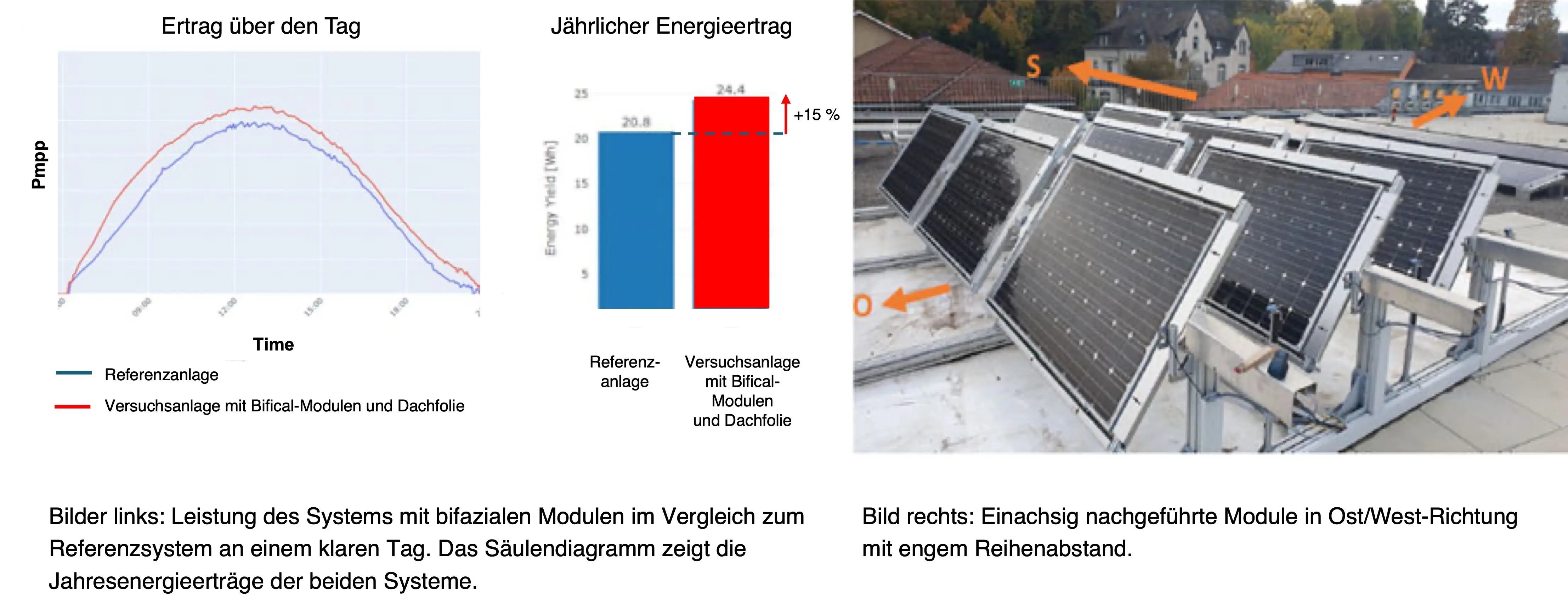Optimising the electricity yield of photovoltaics on flat roofs
With which measures can the energy yield of photovoltaic systems on flat roofs be optimised? Researchers at the ZHAW investigated various concepts in this regard. Among other things, they found that the use of bifacial modules in conjunction with a reflective roof foil can increase the annual energy yield by 15% compared to standard systems. In addition, initial studies with new types of dynamically controlled reflectors have shown that up to 30% more electricity can be generated on individual days thanks to these.
The currently most common type of installation for PV systems on flat roofs is the east-west orientation of modules at low tilt angles, which enables high roof occupancy and serves as a reference system. Researchers from the Institute of Energy Systems and Fluid Engineering (IEFE) at the ZHAW School of Engineering have investigated various ways in which the energy yield of PV systems on flat roofs can be increased compared to this type of system.
In the first concept, the use of bifacial PV modules - i.e. modules that can convert light into electricity on both sides - was investigated. These were elevated above the ground keeping the same angle of inclination as the reference system. In addition, a reflective film was laid on the roof. The measurements showed an additional annual yield of 15%. As the test setup is rather small compared to the systems in practice and the edge area is larger than average, the additional yield is likely to be lower in real systems.
Another test arrangement was the use of horizontal, single-axis tracking systems (HSAT). These systems rotate the solar modules and thus capture more sunlight. In order to maximise the energy yield per area, the tracked modules were positioned as close together as possible. However, the dense occupancy only allows a small tracking angle - change in inclination towards the sun - of the modules. In the test system, the angle range was therefore limited to ±5° in order to avoid shading neighbouring modules. The measurement results show that the annual energy yield can be increased by around 5% compared to the reference system using single-axis, horizontal tracking. This is despite the fact that the angle range is very limited at ±5°.
Stronger solar radiation with reflectors
The researchers at the Institute of Energy Systems and Fluid Engineering (IEFE) have also tested reflectors that increase the irradiation on the PV modules. The reflectors are positioned at the edge of the PV system and are retracted or extended depending on the position of the sun and the weather. The effect was surprisingly strong: on some days, the energy yield of the PV system increased by up to 30% - especially in the mornings and evenings when the sun is lower.
Future plans
In future, the IEFE researchers want to investigate in more detail which PV systems on flat roofs can lead to economical solutions, particularly taking into account hourly time-dependent electricity tariffs, as are likely to be introduced in Switzerland.
More about application-oriented photovoltaics on the ZHAW Photovoltaics Platform
The ZHAW School of Engineering presents its expertise in the field of application-oriented photovoltaics for industry and R&D partners on the Photovoltaics platform: https://www.zhaw.ch/de/engineering/forschung/plattformen/photovoltaik
Project Name
PV-Eye – Photovoltaic systems on flat roofs with highest energy yields per area
Participants
Project Leader: Hartmut Nussbaumer
Project Team: Roger Hiltebrand, Selina Pfyffer, Lona Tulinski, Janis Preisig, Markus Klenk
Third party funding: Bundesamt für Energie, Stefan Oberholzer
Project Duration
December 2021 to March 2025
Publications
Highest Energy Yields per Area for PV Systems on Flat Roofs
https://userarea.eupvsec.org/proceedings/EU-PVSEC-2024/4DV.4.10/

